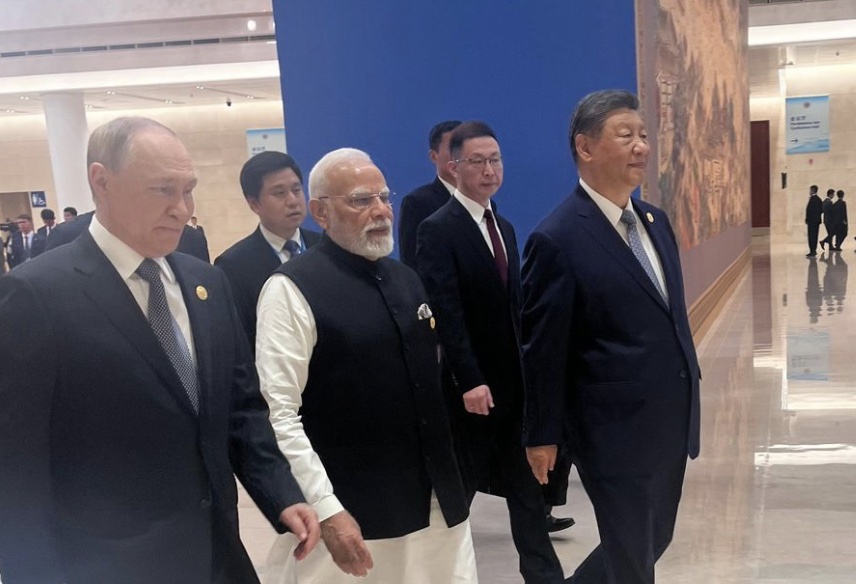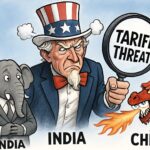When India’s Prime Minister Narendra Modi shook hands with China’s President Xi Jinping and Russia’s Vladimir Putin at the Shanghai Cooperation Organization summit in Tianjin, the headlines wrote themselves: India is in bed with China; punitive tariffs pushing India into Beijing’s arms.
Much of the commentary framed it as fallout from Washington’s punishing 50 percent tariff on Indian goods, tariffs partly justified by New Delhi’s continued purchase of Russian oil. Yes, PM Modi’s visit to China came after a seven-year gap. Yes, it was politically loaded. However, framing it as a simple reaction to tariffs oversimplifies the complexities of India’s balancing act and overlooks the fact that India and the United States are too strategically intertwined to let a single episode define their relationship.
The reality is more layered. PM Modi and President Xi met at the BRICS summit in Kazan last year, their first formal engagement since the 2020 Himalayan border clash, which signaled a tentative thaw in bilateral relations. Their subsequent meeting in Tianjin at the SCO summit was the result of sustained diplomatic engagement, as both leaders affirmed stabilizing ties, agreed to resume direct flights, expand border trade, revive business exchanges, and described each other as “partners, not rivals.”
In Washington, the signals are mixed. Advisors in the Oval Office continue to express unease over India’s oil imports from Russia. Yet President Trump himself has struck a warmer tone, recently declaring, “We get along with India very well.” Jason Miller, his former adviser and now a U.S. lobbyist for India, posted a photo with the President on X—an image that hinted at more than symbolism.
Commerce Secretary Scott Bessent has voiced optimism, and India’s Commerce Minister Piyush Goyal has suggested a trade deal could arrive by Diwali. Both sides are bruised but pragmatic. The real question is whether New Delhi seizes this moment to reset relations rather than simply repair them. Trade negotiations have reached an impasse, with Washington pressing for concessions that India has been unwilling to make.
To break the current deadlock, New Delhi may need to move beyond familiar bargaining chips and turn to unconventional opportunities that resonate with the Trump Administration. One such frontier lies in Alaska.
Alaska’s LNG: More Than an Energy Project
Anchorage has recently re-emerged on the global stage, hosting a U.S.–Russia summit, the first such meeting on American soil in more than a decade. The symbolism was striking, but the substance was even more so. Alaska is no longer America’s frozen backyard; it is a strategic crossroads of energy and geopolitics. At the heart of this lies the long-delayed Alaska LNG project, a $44 billion venture with an 800-mile pipeline and liquefaction facility.
President Trump has branded the Alaska project as a strategic game-changer for U.S. exports to Asia. For Asian nations, it is seen less as another LNG source and more as a long-term hedge for energy security that also helps narrow trade imbalances with Washington.
Thailand’s PTT has already signed a 20-year off-take deal, Japan has commissioned feasibility studies, and India’s GAIL is in talks for long-term supply and possible equity participation. For New Delhi, the appeal lies not only in diversifying energy but also in easing tensions over its growing trade surplus with the U.S., sharpened by President Trump’s recent tariff escalation.
Why India Should Step In
This is not simply a commercial deal. It is about narrative, leverage, and strategy.
Economic calculus: LNG imports from Alaska would help India diversify away from volatile Middle Eastern supplies, cut shipping time compared to Gulf Coast cargoes that must negotiate the Panama Canal, and narrow its trade surplus with Washington, an irritant that has fueled the tariff war.
Political signaling: A visible role in Alaska would demonstrate that India is willing to invest in U.S. strategic projects even while it pragmatically buys oil from Russia. It reframes India not as drifting toward Beijing or clinging to Moscow, but as a partner in America’s Arctic future.
Strategic continuity: Under the U.S.–India COMPACT, launched during PM Modi’s February 2025 Washington summit with President Trump, LNG was explicitly listed as a pillar of bilateral energy trade. Alaska offers a chance to operationalize that pledge and expand the partnership into one of the most contested regions of this century—the Arctic.
India’s Arctic Credentials
Skeptics may ask: why would India bet on a costly, uncertain project thousands of miles away? But India is no stranger to Arctic energy. ONGC Videsh already holds a 20 percent stake in Russia’s Sakhalin-I, just across the Bering Strait from Alaska. GAIL has partnered with Russia’s Novatek on regasification terminals. Indian engineers and service firms are present in Russia’s Far East oil and gas ventures. The technical expertise and institutional familiarity are there. What is missing is the political will to shift some of that experience westward, into the U.S. Arctic.
A Reset with Symbolism
Partnership in Alaska would not be a quick fix to tariffs or trade frictions, but it would send a clear signal that India can think long-term. Announcing such a deal around Diwali, the festival of renewal, would add symbolic weight and underscore India’s intent to mark a new phase in ties with Washington, affording New Delhi the diplomatic capital to break the current impasse and a longer runway to negotiate a win-win trade deal.
India–U.S. relations have endured darker days, from Cold War suspicion to post-Pokhran sanctions, sustained by shared democratic values and converging strategic interests. Today, those interests intersect not only in the Indo-Pacific but also in the Arctic, where energy, security, and climate collide and where China’s growing presence is expanding at an alarming pace. Seizing the Alaska LNG opportunity will require capital, coordination, and courage. But the payoff is considerable: positioning India not merely as a buyer of American energy but as an emerging stakeholder in shaping U.S. Arctic strategy.






